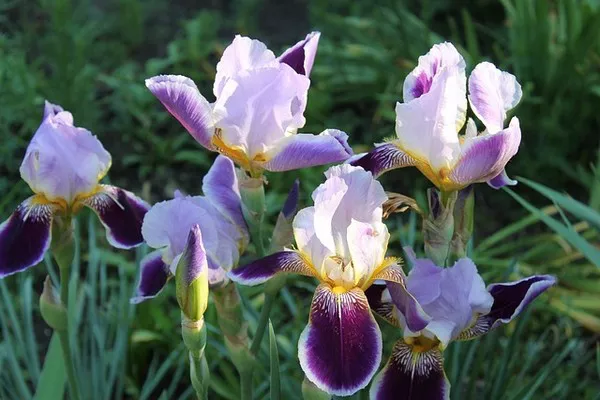Iris flowers, renowned for their striking beauty and diverse array of colors, are beloved by gardeners and florists worldwide. With over 300 species and countless cultivars, the genus Iris offers an extensive palette of floral varieties, each with its own unique characteristics and charm. In this article, we delve into the fascinating world of Iris flowers, exploring their taxonomy, characteristics, and the myriad types that grace gardens, landscapes, and floral arrangements around the globe.
Taxonomy of Iris Flowers
Before delving into the multitude of Iris varieties, it’s essential to understand the taxonomic structure of this diverse genus. Iris belongs to the family Iridaceae, which comprises over 80 genera and more than 2,000 species. Within the genus Iris, species are further categorized into subgenera, sections, and series based on morphological and genetic characteristics.
The three main subgenera of Iris are:
1. Subgenus Iris: This subgenus includes bearded irises, characterized by the presence of a fuzzy “beard” on the falls (lower petals) of the flower. Bearded irises are among the most popular and widely cultivated types, prized for their vibrant colors and intricate patterns.
2. Subgenus Limniris: Limniris encompasses several groups, including beardless irises, such as Siberian irises and Japanese irises. These irises lack the distinctive beard found in Subgenus Iris and are valued for their graceful form and delicate blooms.
3. Subgenus Xiphium: This subgenus comprises bulbous irises, commonly known as Dutch irises. Unlike their rhizomatous or fibrous-rooted counterparts, bulbous irises grow from bulbs and are cherished for their elegant, upright flowers.
Each subgenus further contains sections and series that classify species based on specific morphological features, geographic distribution, and genetic relationships. This taxonomic framework provides a systematic way to organize the vast diversity of Iris species and cultivars.
Popular Types of Iris Flowers
Within the genus Iris, numerous species and cultivars captivate enthusiasts with their beauty and diversity. While it’s impossible to cover every type in a single article, we’ll explore some of the most popular and noteworthy varieties across different subgenera.
1. Bearded Irises (Subgenus Iris):
Bearded irises are perhaps the most familiar and widely cultivated type, renowned for their showy flowers and distinctive beards. Within this category, several groups stand out:
Tall Bearded Irises (Iris germanica): Known for their tall flower stems and large blooms, tall bearded irises are available in a vast array of colors, from rich purples and blues to soft pinks and whites. Popular cultivars include ‘Immortality,’ ‘Victoria Falls,’ and ‘Sultan’s Palace.’
Border Bearded Irises: These irises are shorter in stature than tall bearded varieties but still boast impressive blooms. Border bearded irises are prized for their versatility, making them suitable for borders, rock gardens, and containers. Notable cultivars include ‘Raspberry Blush,’ ‘Autumn Circus,’ and ‘Earl of Essex.’
Miniature Dwarf Bearded Irises: As the name suggests, miniature dwarf bearded irises are petite in size but pack a punch with their charming flowers. Perfect for small gardens or container growing, these diminutive irises add a touch of whimsy to any landscape. Popular choices include ‘Blue Chip’, ‘Dainty Maid’, and ‘Tiny Titan.’
2. Beardless Irises (Subgenus Limniris):
Beardless irises encompass a diverse group of species, each with its own unique characteristics and growing requirements. Some of the most notable types include:
Siberian Irises (Iris sibirica): Siberian irises are celebrated for their graceful foliage and dainty flowers, which appear in early to mid-summer. These hardy perennials thrive in moist, well-drained soil and are available in an array of colors, including blue, purple, white, and yellow. Popular cultivars include ‘Caesar’s Brother,’ ‘Silver Edge,’ and ‘Butter and Sugar.’
Japanese Irises (Iris ensata): With their large, ruffled blooms and bold colors, Japanese irises make a stunning addition to water gardens and moist, boggy areas. These irises are characterized by their flattened flower stems and often exhibit intricate patterns and veining. Notable varieties include ‘Variegata’, ‘Pink Lady’, and ‘Lion King.’
Louisiana Irises (Iris hexagona): Native to the southeastern United States, Louisiana irises are prized for their vibrant colors and adaptability to wetland habitats. These irises thrive in moist to wet soil and produce large, showy flowers in shades of purple, blue, white, and yellow. Popular cultivars include ‘Black Gamecock,’ ‘Bengal Tiger,’ and ‘Lady of the Night.’
3. Bulbous Irises (Subgenus Xiphium):
Bulbous irises, also known as Dutch irises, are characterized by their slender stems and elegant, cup-shaped flowers. While not as widely grown as bearded or beardless irises, Dutch irises offer a unique beauty and charm:
Dutch Iris (Iris × hollandica): Dutch irises are prized for their long-lasting cut flowers and bold color palette, which includes shades of blue, purple, white, and yellow. These irises are easy to grow and make excellent additions to cut flower arrangements. Popular cultivars include ‘Blue Magic,’ ‘White Excelsior,’ and ‘Golden Beauty.’
Reticulata Irises (Iris reticulata): Reticulata irises are among the earliest bloomers in the iris family, often flowering in late winter to early spring. These diminutive irises feature intricate markings and bold colors, making them a delightful sight after the winter months. Notable varieties include ‘Harmony,’ ‘Pauline,’ and ‘Katharine Hodgkin.’
Conclusion
The world of Iris flowers is vast and diverse, offering a multitude of species and cultivars to suit every gardener’s taste and preference. From the majestic blooms of tall bearded irises to the delicate charm of reticulata irises, each type brings its own unique beauty to gardens, landscapes, and floral arrangements around the world. By exploring the taxonomy and characteristics of Iris flowers, enthusiasts can deepen their appreciation for these exquisite plants and discover new favorites to cultivate and enjoy.


